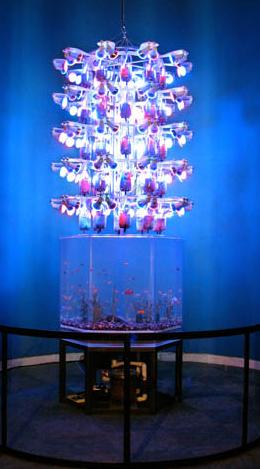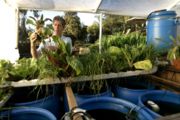Difference between revisions of "Food/Aquaponics"
From AdCiv
< Food
| Line 2: | Line 2: | ||
[http://www.thegreencenter.net/ The New Alchemy Institute] did a lot of research into aquaculture - small scale production of fish for eating. They found that a fish tank five feet in diameter and five feet tall can produce forty pounds of fish a year. (Meaning that you could have fish for dinner twice a week.) They perfected the method for growing tilapia, catfish or shrimp and even developed computer algorithms which could accurately predict the yield of fish based on variables [http://www.thegreencenter.net/pdf/solaraqua.pdf]. | [http://www.thegreencenter.net/ The New Alchemy Institute] did a lot of research into aquaculture - small scale production of fish for eating. They found that a fish tank five feet in diameter and five feet tall can produce forty pounds of fish a year. (Meaning that you could have fish for dinner twice a week.) They perfected the method for growing tilapia, catfish or shrimp and even developed computer algorithms which could accurately predict the yield of fish based on variables [http://www.thegreencenter.net/pdf/solaraqua.pdf]. | ||
| − | [[Image:Farmfountain.jpg|thumb| | + | [[Image:Farmfountain.jpg|thumb|400px|[http://farmfountain.com/ Farm Fountain] is 'a sculptural ecosystem you can eat'. The design, by Ken Rinaldo and Amy Youngs, is available under a Creative Commons license and their website gives instructions on [http://farmfountain.com/howto/index.html how to build your own]. The fish tank at the bottom produces edible fish and effluent-enriched water, which is circulated among the bottles above, where plants are grown hydroponically.]]Ron Zweig developed a method in which the fish tank doubles as a source of hydroponic vegetables. Vegetables are grown on the surface of the pond so that their roots dangle into the water; the fish fertilize the plants, the plants clean the water, and both can be eaten by humans. This symbiotic growth of aquatic animals and hydroponic plants became known as {{wp|Aquaponics|aquaponics}}. Aquaponics is a sustainable and extremely resource-efficient method of food production, requiring no input but sunlight. |
Algae could also be grown on the surface of the water, providing a source of food for the fish so that they would not require feeding. Many species of algae are also edible by humans. | Algae could also be grown on the surface of the water, providing a source of food for the fish so that they would not require feeding. Many species of algae are also edible by humans. | ||
Revision as of 22:27, 4 October 2010
The New Alchemy Institute did a lot of research into aquaculture - small scale production of fish for eating. They found that a fish tank five feet in diameter and five feet tall can produce forty pounds of fish a year. (Meaning that you could have fish for dinner twice a week.) They perfected the method for growing tilapia, catfish or shrimp and even developed computer algorithms which could accurately predict the yield of fish based on variables [1].

Farm Fountain is 'a sculptural ecosystem you can eat'. The design, by Ken Rinaldo and Amy Youngs, is available under a Creative Commons license and their website gives instructions on how to build your own. The fish tank at the bottom produces edible fish and effluent-enriched water, which is circulated among the bottles above, where plants are grown hydroponically.
 . Aquaponics is a sustainable and extremely resource-efficient method of food production, requiring no input but sunlight.
. Aquaponics is a sustainable and extremely resource-efficient method of food production, requiring no input but sunlight.
Algae could also be grown on the surface of the water, providing a source of food for the fish so that they would not require feeding. Many species of algae are also edible by humans.
